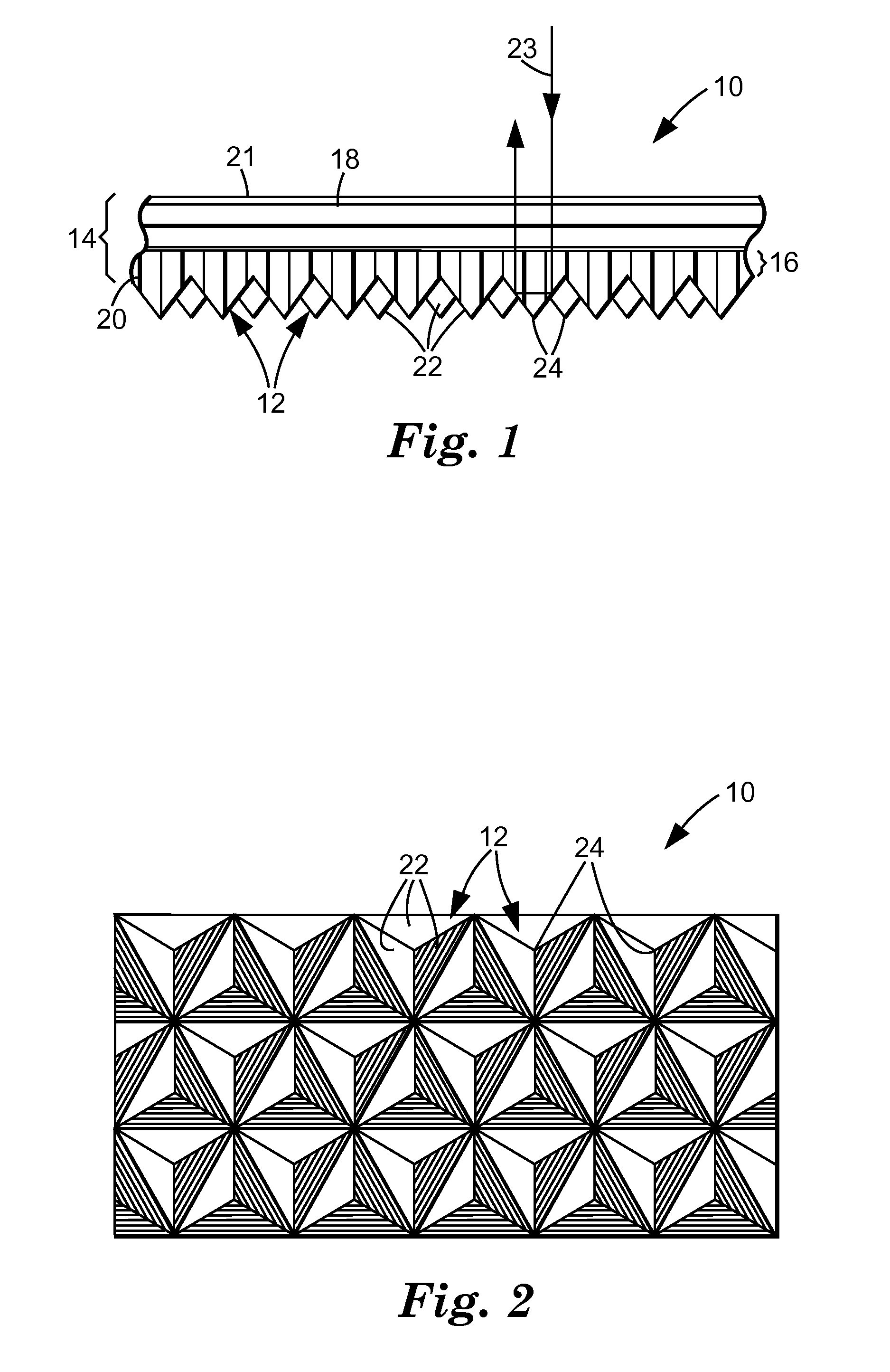Flexible cube-corner retroreflective sheeting
a cube-corner and retroreflective technology, applied in the field of flexible cube-corner retroreflective sheeting, can solve the problems of not being able to disclose the combination of higher elastic modulus cubes and low elastic modulus body layers, and achieve extraordinary dimensional stability during flexing, good retroreflective performance, and high flexibility
- Summary
- Abstract
- Description
- Claims
- Application Information
AI Technical Summary
Benefits of technology
Problems solved by technology
Method used
Image
Examples
example 2
[0060] A second sample was produced by the procedure outlined in Example 1, except the body layer was a previously extruded 79 micrometer (0.0031 inch) thick, continuous, poly(ethylene-co-acrylic acid) film (Primacor™ 3440, material supplied by The Dow Chemical Company, Midland, Mich.). An aliphatic polyester urethane primer was applied to promote adhesion of this film to the poly(carbonate) surface. The primer (Q-Thane™ QC-4820, supplied by K.J. Quinn and Co., Inc., Seabrook, N.H., was solvent coated to form a layer having a final dried thickness of approximately 2.5 micrometers (0.0001 inch).
example 3
[0061] A third sample was produced by the procedure outlined in Example 1, except the body layer was a previously extruded 71 micrometer (0.0028 inch) thick aliphatic polyester urethane body layer (Morthane™ PNO3, supplied by Morton International, Seabrook, N.H.).
[0062] Table 1 summarizes the elastic modulus of the body layer material for the laminate samples evaluated in Examples 1-3. Elastic modulus was determined according to ASTM D882-75b using a Sintech 1 static weighing constant rate-of-grip separation tester, produced by MTS Systems Corp, Eden Prairie, Minn. Elastic modulus for the poly(carbonate) used in the cubes and land layer for all samples was 20.0×108 pascals (29.1×104 psi).
TABLE 1ExampleBody LayerNumberMaterialElastic Modulus1polymethylmethacrylate24.4 × 108 pascal(35.4 × 104 psi)2poly(ethylene-co-acrylic acid)1.24 × 108 pascal(1.80 × 104 psi)3aliphatic polyester urethane0.34 × 108 pascal(0.50 × 104 psi)
[0063] The samples of Examples 1-3 were tested for apparent be...
PUM
| Property | Measurement | Unit |
|---|---|---|
| elastic modulus | aaaaa | aaaaa |
| elastic modulus | aaaaa | aaaaa |
| thickness | aaaaa | aaaaa |
Abstract
Description
Claims
Application Information
 Login to View More
Login to View More - R&D
- Intellectual Property
- Life Sciences
- Materials
- Tech Scout
- Unparalleled Data Quality
- Higher Quality Content
- 60% Fewer Hallucinations
Browse by: Latest US Patents, China's latest patents, Technical Efficacy Thesaurus, Application Domain, Technology Topic, Popular Technical Reports.
© 2025 PatSnap. All rights reserved.Legal|Privacy policy|Modern Slavery Act Transparency Statement|Sitemap|About US| Contact US: help@patsnap.com



